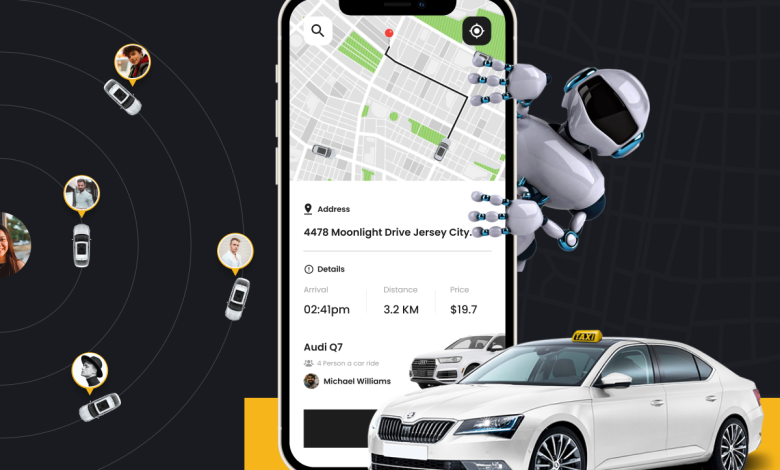
In recent years, the taxi industry has undergone a massive transformation. Traditional ride-hailing models that once relied solely on human drivers and manual systems are now being reshaped by technology—particularly Artificial Intelligence (AI). From Uber’s early adoption of predictive algorithms to the growing presence of local startups leveraging smart solutions, the impact of AI on the taxi ecosystem has been revolutionary.
One of the most significant outcomes of this technological evolution has been the rise of AI powered taxi apps. These intelligent platforms are not just improving the experience for riders but also enhancing efficiency, profitability, and sustainability for operators. Whether you’re an entrepreneur entering the mobility market or a business leader exploring new opportunities, understanding the advantages of building an AI-driven taxi application is crucial.
In this article, we will explore the key benefits of AI-powered solutions in the taxi industry and why businesses are increasingly turning to a specialized taxi app development company or an experienced AI app development company to bring their visions to life.
1. Enhanced Rider Experience
The primary advantage of an AI-powered taxi application is the ability to deliver a seamless and personalized experience to riders. AI algorithms analyze user data—such as frequently visited locations, ride history, and preferred payment methods—to provide tailored recommendations. For instance, a passenger who frequently commutes from home to the office at 8 a.m. might receive proactive ride reminders, faster vehicle allocation, or discounts for recurring trips.
AI also ensures shorter wait times by intelligently matching riders with nearby drivers and optimizing routes in real time. This not only reduces frustration but also builds customer loyalty in a competitive market.
2. Intelligent Route Optimization
Gone are the days when taxi drivers relied solely on GPS navigation. AI-powered systems now go a step further by analyzing traffic data, roadblocks, weather conditions, and real-time events to determine the fastest and most efficient route.
For riders, this means quicker trips and reduced fares. For drivers, it translates into more completed rides per day, improving overall earnings. The ability to dynamically adapt to changing traffic conditions makes AI-powered taxi apps far more efficient than traditional ride-hailing platforms.
- Predictive Demand Forecasting
One of the most game-changing advantages of AI in taxi apps is predictive analytics. Using historical ride data, AI can forecast demand patterns with impressive accuracy. For example, the system can anticipate a surge in ride requests in downtown areas during peak office hours or near stadiums during sporting events.
This allows operators to strategically position drivers in high-demand zones, reducing idle time and ensuring that passengers never struggle to find a ride. Predictive forecasting also empowers businesses to plan promotions and adjust pricing models to maximize revenue during peak hours.
4. Smarter Driver Allocation and Fleet Management
For taxi businesses, one of the toughest challenges is managing their driver network efficiently. AI-driven allocation systems consider multiple variables—distance to the passenger, driver availability, vehicle type, and even driver performance history—before assigning a ride.
This eliminates biases, reduces wait times, and ensures that drivers are utilized to their full potential. Fleet operators can also use AI-powered dashboards to monitor driver behavior, fuel efficiency, and vehicle health, ultimately lowering operational costs.
5. Safety and Security Enhancements
Safety is one of the most critical aspects of the ride-hailing industry. AI-powered features such as facial recognition for driver verification, real-time ride tracking, and anomaly detection have significantly improved passenger security.
For example, if an AI system detects an unusual route deviation or prolonged stop during a trip, it can send alerts to both the rider and the operator. Moreover, AI can be integrated with emergency response systems to provide immediate support in case of accidents or incidents, boosting trust among passengers.
6. Fraud Detection and Prevention
Fraudulent activities, such as fake ride requests or payment scams, are common in traditional taxi systems. AI helps mitigate these risks by analyzing transaction patterns and user behavior to identify suspicious activity.
For instance, if a passenger repeatedly cancels rides or uses multiple accounts from the same device, the system can automatically flag the behavior for review. Similarly, AI can detect unusual driver activities—like manipulating GPS signals or overcharging—ensuring fairness and transparency across the platform.
7. Personalized Marketing and Retention
AI doesn’t just optimize rides—it also transforms how businesses interact with their customers. With access to data-driven insights, operators can launch highly personalized marketing campaigns.
Imagine a system that automatically sends a discount code to users who haven’t booked a ride in two weeks or offers premium services to loyal customers based on their preferences. By delivering the right message to the right user at the right time, AI-powered taxi apps drive higher engagement and customer retention.
8. Cost Efficiency for Businesses
Building a taxi app is a significant investment, but AI ensures that businesses maximize their returns. By improving driver allocation, reducing idle times, cutting fuel expenses, and preventing fraudulent activities, AI directly contributes to cost savings.
Additionally, AI can automate tasks such as customer support via chatbots, minimizing the need for large support teams. Over time, this translates into improved profitability for taxi operators and better scalability for growing businesses.
9. Integration with Smart Cities and IoT
As cities move toward becoming “smart,” AI-powered taxi platforms are becoming integral to urban mobility ecosystems. By integrating with Internet of Things (IoT) devices such as smart traffic lights, city parking systems, and connected vehicles, these apps can enhance coordination and reduce congestion.
For example, an AI system connected to smart traffic signals can dynamically reroute vehicles to avoid gridlock. This not only improves rider satisfaction but also contributes to greener, more sustainable urban environments.
10. Competitive Advantage in a Crowded Market
The ride-hailing industry is one of the most competitive spaces in the tech-driven business world. Companies that adopt AI technologies early gain a significant edge. Customers today expect faster service, safer rides, and personalized experiences—and AI delivers on all fronts.
By partnering with a reliable AI app development company, businesses can ensure that their taxi application is equipped with advanced features that differentiate them from competitors. Similarly, choosing a specialized taxi app development company ensures that the solution is built with scalability, compliance, and industry best practices in mind.
11. Environmental Benefits
Sustainability has become a global priority, and AI is playing a vital role in making transportation eco-friendlier. By optimizing routes and reducing idle driving, AI helps lower fuel consumption and emissions.
Furthermore, AI systems can prioritize electric or hybrid vehicles for short-distance rides, contributing to greener city environments. For businesses, this not only aligns with global sustainability goals but also appeals to environmentally conscious customers.
12. Future-Proofing the Taxi Industry
The taxi industry is evolving rapidly, with emerging technologies like autonomous vehicles, 5G connectivity, and blockchain reshaping the future. AI-powered taxi apps serve as the foundation for these next-generation innovations.
For example, the transition to self-driving taxis will be heavily reliant on AI for navigation, safety, and passenger interactions. Businesses that invest in AI-powered solutions today are positioning themselves to thrive in tomorrow’s mobility landscape.
Conclusion
Building an AI-powered taxi app is no longer just a technological upgrade—it is a business necessity. From enhancing customer experiences and optimizing routes to ensuring safety and reducing costs, AI brings unparalleled advantages to the ride-hailing industry.
Operators who embrace these intelligent systems stand to gain not just immediate efficiency improvements but also long-term competitive strength in an evolving market. Whether you are working with a taxi app development company to bring your idea to life or collaborating with an AI app development company for advanced features, the integration of AI is the smartest move for businesses aiming to dominate the mobility space.
In short, AI powered taxi apps are shaping the future of transportation—making it smarter, safer, and more sustainable. And for businesses willing to invest in innovation, the road ahead is filled with endless opportunities.




